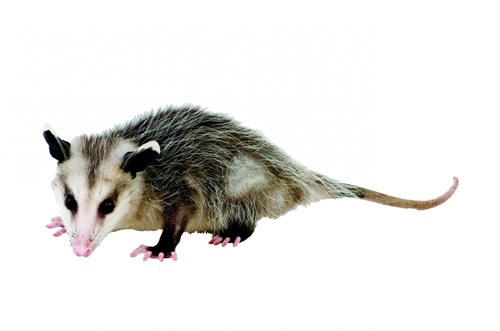Typical Opossum Appearance
The only marsupial found in North America, opossums are easily identified due to their long tails, pointed faces, and large, hairless ears. They are generally gray in color, though their coats may vary from red to brown. The pests also have a somewhat grizzled appearance due to the long, white-tipped guard hairs on their thick fur. Opossum tails lack hair and serve as an additional limb to help in climbing.

Issues Caused
Opossums create numerous problems for homeowners. These notoriously nocturnal pests can sneak into yards and outbuildings completely undetected, though the effects of their presence are perfectly clear the next day. Opossums may knock over garbage cans in order to gain access to easy meals, which they also make out of unattended pet food. They will also den under sheds, especially when rearing their young. In addition, these pests carry numerous parasites and can spread disease.
Controlling Opossums
The phrase “playing possum” has come to be associated with pretending to be dead. While opossums can enter a catatonic state to make predators lose interest, this is actually a rare occurrence. Instead, they usually bare their sharp teeth and stand their ground when confronted by people or pets. In order to avoid being bitten or scratched, never try to trap these pests without professional assistance. The experts at Critter Control have the knowledge, skills, and tools to properly identify and eliminate opossums from the premises.


Learn more about Opossum Removal.
Get them out.
Keep them out.®
Experiencing a wildlife or pest issue? We can help! Complete this form and your local Critter Control® office will contact you to assist.
- How to Identify Opossum Noises
- Are Opossums Dangerous?
- Opossum Diet
- Opossum Droppings
- Opossum Playing Dead
- Opossum Tracks
- Opossums and Rabies
- Opossum Babies: Identification & Concerns
- Opossums in the Attic
- Opossums in the Day
- Opossums in the Walls – Prevention & Removal
- Opossums and Ticks: Do Opossums Eat Ticks?
- Do Opossums Hibernate in the Winter?
- Opossums on the Roof
- Opossum Under Your House, Deck, or Shed